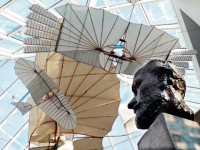Parseval-Naatz-Luftschiff PN-28
Nach dem ersten Weltkrieg verlagerte die Luft-Fahrzeug-Gesellschaft, die vor allem durch den Bau der Parseval-Luftschiffe bekannt geworden war ihre Luftschiffbau Abteilung von Bitterfeld in Mitteldeutschland nach Seddin bei Stolp (Slupsk) in Hinterpommern.
Der dort ab 1927 als Wasser- und Luft-Fahrzeug GmbH weitergeführte Firma baute dort in den Jahren 1928 bis 1932 drei kleine Reklameluftschiffe der Konstruktion Parseval-Naatz. PN 28 unternahm seine erste Fahrt am 6.6.1929 in Berlin unter dem Namen Trumpf und führte zahlreiche Fahrten für den Schokoladenhersteller Trumpf über Mitteldeutschland aus.
Technische Daten:
Volumen: 1800 m³
Länge: 39,5 m
Max. Durchmesser: 10,5 m
Antrieb: 1x 59 kW/80PS Siemens Halske 13
Steighöhe: 1000 m
Geschwindigkeit: 80 Km/h
Mitfahrer: 1Pilot + max. 4Passagiere
Halbstarre Konstruktion
en

